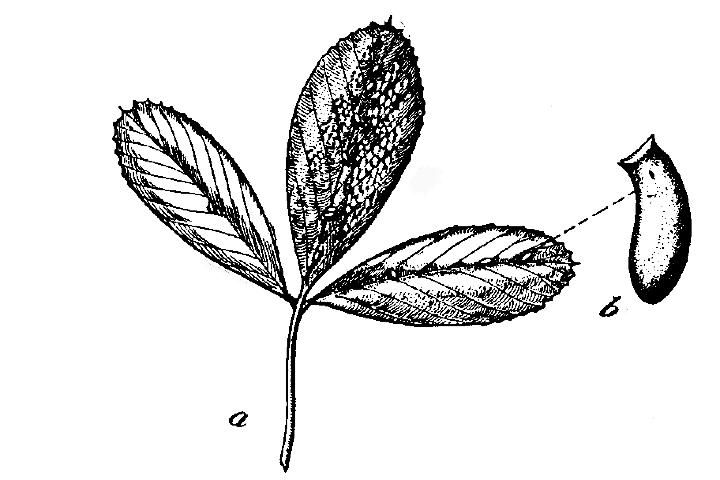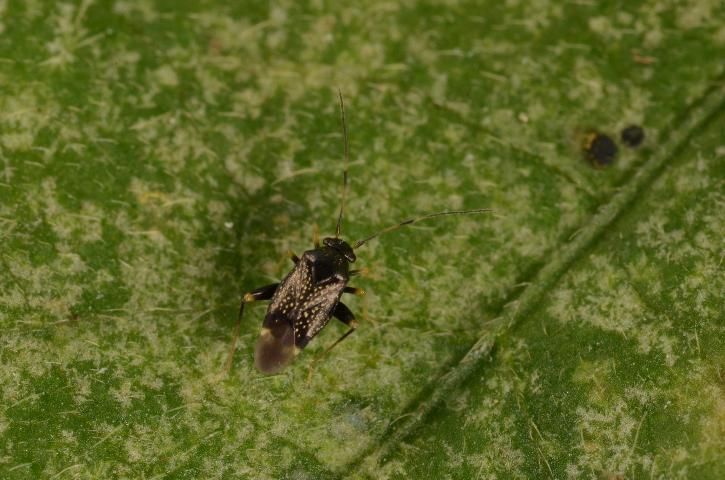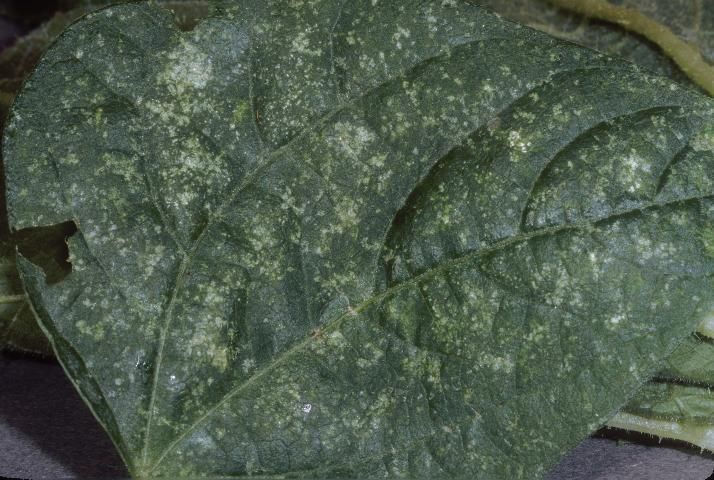Garden Fleahopper, Microtechnites bractatus (Say) (Hemiptera: Miridae)
The Featured Creatures collection provides in-depth profiles of insects, nematodes, arachnids, and other organisms relevant to Florida. These profiles are intended for the use of interested laypersons with some knowledge of biology as well as academic audiences.
Introduction
The garden fleahopper is a native insect that occurs widely in the eastern United States and Canada. It is known to occur as far west as the Rocky Mountain region but is relatively uncommon in the Great Plains. Its distribution extends southward through the Caribbean region to Central and South America to Brazil. It also is known from Hawaii. In Florida, it is a common garden pest, though not commonly a pest of commercial crops.

Description and Life Cycle
There appears to be five generations annually in Virginia, although there is considerable overlap among the generations, and all stages can be found through the warmer months. A life cycle can be completed in about 30 days. Overwintering occurs in the egg stage, with hatch of overwintering eggs occurring in April. In Florida, fleahoppers are present earlier in the season, and it has not been determined whether eggs hatch earlier or whether adults are the predominant overwintering form. However, adults have been captured all months of the year except December, so overwintering of eggs is not essential under Florida's warm winter conditions. Peak abundance seems to occur in May of most years. Temperatures above 32°C (89.6°F) are reported to be unsuitable for fleahopper survival.
Egg
The eggs are normally inserted into the stems of vegetation. They are white to yellow in color, and measure about 0.7 mm in length and 0.2 mm (< 1/32 in) in width. The egg is curved in shape, with one side convex and the opposite side concave. The female deposits the eggs in feeding punctures. The end inserted into the plant tissue is rounded whereas the end that is flush with the plant surface is truncate and level with the surface of the plant tissue. The female commences egg production about four days after mating and deposits most eggs during the evening hours. She produces 80 to 100 eggs during her life span, which averages about 30 to 50 days. Duration of the egg stage is about 14 days, with a range of about 10 to 30 days.

Credit: USDA
Nymph
The nymphs are green in color. Initially they are pale green, but by the fifth (final) instar they are dark green. First and second instars are difficult to distinguish, differing principally in size. In the third instar, however, a black dot is present on the sides of the prothoracic segment; the black spots persist through the remaining nymphal stages. In the fourth instar, wing pads are apparent, and extend back over the first abdominal segment. During the last instar, the wing pads extend over about half of the abdominal segments. In females which are brachypterous (short-winged) as adults, the wing pads in the fifth instar tend to be slightly less than one-half the length of the abdomen. In males, or females which will be macropterous (long-winged) as adults, the wing pads in the fifth instar tend to be slightly longer than one-half the length of the abdomen. The mean duration of each instar is about 8.3, 9.9, 7.8, 5.8, and 7.2 days, respectively. Body length of each instar is about 0.7, 0.8, 1.0, 1.2, and 2.0 mm (< 1/32, < 1/32, 1/32, 1/32, and 1/16 in), respectively.

Credit: Paul M. Choate, UF/IFAS
Adult
The adults are shiny black in color, with some yellow on the antennae and legs. Garden fleahopper adults occur in three forms: brachypterous (short-winged) females (Figure 4), macropterous (long-winged) females, and macropterous males (Figure 5). The males are thin, measuring about 1.9 to 2.1 mm (1/16 in) in length and 0.7 mm (< 1/32 in) in width. The females are more robust, the brachypterous form measuring about 1.6 mm (1/16 in) in length and the macropterous form measuring about 2.2 mm (1/16 in) in length, with both forms about 1.0 mm (1/32 in) in width. Females generally are brachypterous. The adults have greatly expanded hind femora and hop when disturbed. Thus, in both behavior and form (especially the brachypterous females) the fleahoppers resemble flea beetles. The long antennae of fleahoppers exceed the length of the body; this helps to distinguish fleahoppers from flea beetles, which have antennae less than half the length of the body. Fleahoppers and flea beetles also differ in their mouthpart configuration, having piercing-sucking and chewing mouthparts, respectively.

Credit: Lyle Buss, UF/IFAS

Credit: Lyle Buss, UF/IFAS
Damage
Nymphs and adults frequent the stems and surfaces of plant leaves, sucking the sap from individual cells and causing their death. The result is a whitish or yellowish speckling on the foliage. Extensive feeding may cause stunting of plant growth and death of seedlings. Deposition of black spots of fecal material on the plant (usually on the underside of the leaf) by both nymphs and adults also detracts from the appearance and marketability of vegetables.

Credit: Paul M. Choate, UF/IFAS

Credit: Paul M. Choate, UF/IFAS
This insect is rarely a pest of commercial vegetable crops because it is easily controlled with insecticides used against other, more serious, pests. However, it is commonly an early season nuisance in home gardens, especially those grown near wooded areas and on plants cultivated in semi-shade.
Host Plants
This fleahopper has a broad host range, but leguminous crops are most frequently damaged. Vegetable crops that host garden fleahopper include bean, beet, cabbage, celery, cowpea, cucumber, eggplant, lettuce, pea, pepper, potato, pumpkin, squash, sweet potato, and tomato. Field crops injured include alfalfa, clover, and sweet clover. Ornamental plants, especially annual and perennial flowering crops such as chrysanthemum, daisy, marigold, and salvia, can be damaged. Some of the common weeds that support garden fleahopper are beggartick, Bidens sp.; bindweed, Convolvulus spp.; burdock, Arctium minus; mallow, Malva spp.; pigweed, Amaranthus spp.; plantain, Plantago spp.; ragweed, Ambrosia spp.; smartweed, Polygonum spp.; prickly lettuce, Lactuca serriola; thistle, Carduus spp.; and wood sorrel, Oxalis stricta. Occasionally it will feed on other insects.
Natural Enemies
Natural control has been poorly studied, but parasitic wasps can inflict high rates of mortality. In the United States, 50% mortality caused by Leiophron uniformis (Gahan) (Hymenoptera: Braconidae) has been observed, and this parasitoid was believed to be regulating bug densities in New Jersey. Leiophron uniformis attacks principally the nymphal stages. In Canada, Peristenus clematidis Loan (Hymenoptera: Braconidae) is known to parasitize garden fleahopper. An unidentified nematode and predatory mite also have been detected in the United States (Beyer 1921, Day and Saunders 1990). Beyer also reported several egg parasitoids, including Anaphes perdubius Girault and Anagrus sp. (both Hymenoptera: Mymaridae), and Oligosita americana Girault and Paracentrobia subflava Howard (both Hymenoptera: Trichogrammatidae).
Management
Suppression is easily accomplished with insecticides, so this insect tends to be a pest of gardens rather than commercially produced crops. Fleahoppers commonly frequent weeds, where they may attain great abundance, and such host plants should be monitored and sprayed or destroyed if necessary. Also, garden fleahopper sometimes builds to high number in leguminous crops such as alfalfa and clover, so nearby vegetables may be at risk when the leguminous forage crops are harvested.
Selected References
Beyer AH. 1921. Garden flea-hopper in alfalfa and its control. USDA Bulletin 964. 27 pp.
Cagle LR, Jackson HW. 1947. Life history of the garden fleahopper. Virginia Agricultural Experiment Station and Technical Bulletin 107. 27 pp.
Capinera JL. 2001. Handbook of Vegetable Pests. Academic Press, San Diego. 729pp.
Day WH, Saunders LB. 1990. Abundance of the garden fleahopper (Hemiptera: Miridae) on alfalfa and parasitism by Leiophron uniformis (Gahan) (Hymenoptera: Braconidae). Journal of Economic Entomology 83:101–106.




